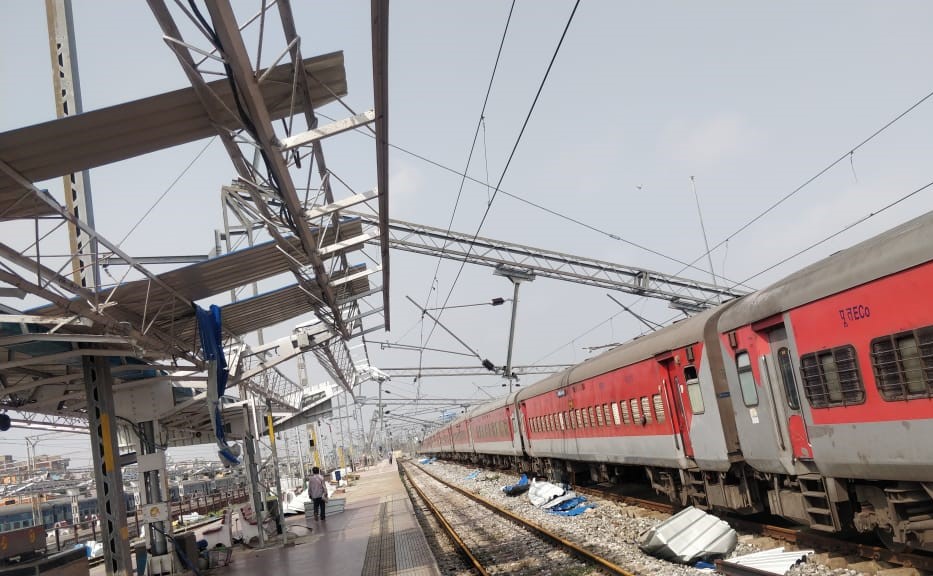Dr Santosh Kumar Mohapatra
As anticipated, the extreme cyclonic storm “Fani” hit the coastal belt of Odiaha ferociously May 3 Morning. It has left a trail of devastation. It was the strongest tropical cyclone to strike Odisha since Phailin in 2013. Fani , with copious rain and windstorm, brought the life to a standstill in major parts of Odisha. It has wrecked havoc in 14 districts with Puri, being the worst affected followed by Khurdha and Cuttack. Other districts such as Bhadhrak, Kendrapara, Jagatsinghpur, Balasore, Mayurbhanja, Keonjhar, Dhenkanal and Nayagarh also severely affected. The wind blew at over a speed of 160-170 km per hour but hit the Puri speed of around 200 km per hour.
Fani originated from a tropical depression that formed west of Sumatra in the Indian Ocean on 26 April. Vertical wind shear at first hindered the storm’s development but conditions became more favorable on 30April. Fani speedily intensified in to an extremely severe cyclonic storm peaked with wind speeds of 204 KM per hour, the equivalent of a high-end category 4 major hurricane. Hurricanes and cyclones are the same and basic weather phenomenon , just located in different regions of the world .Fani weakened before making landfall, and its convective structure rapidly degraded thereafter, dissipating on 5 May.
This apocalypse has triggered a sense of dismay and consternation in the minds of people of Odisha and has revived the ghastly memory and excruciating experience of super cyclone of 1999. The tragedy is that in regular interval, Odisha has been plagued by cyclone. After super cyclone, Odisha has had to cope with Phailin in 2013, Hudhud in 2014, drought in 2018, Titli in 2018 and now the extremely severe tropical storm Fani. In term of causalities, it may not be same dangerous as super cyclone of 1999 which killed 10,000 people, but extent of damage, loss of property, assets is no way less than the super cyclone. Long term impact will be enormous. Chief Minister has rightly described “Fani” as tragedy of humungous proportions.
At least 59 people have been killed by Cyclone Fani of which 37 in Odisha, 8 in two districts of Uttar Pradesh and 14 in eight districts of Bangladesh. However, death tolls in Odisha as per unofficial figure are more than 65. Around 1.37 crore people, 14835 villages and 46 urban centers have been affected adversely. Around 2 lakh people are rendered homeless and road, power, and telecom infrastructure has been destroyed in vast areas.
The catastrophe left a trail of devastation by flattening houses with thatched roofs, shattering windows, uprooting or collapsing electric poles and mobile towers,. Fani has taken heavy toll on status’s green cover. Over 10 million trees have been uprooted with equal number of trees damaged in the extremely severe cyclone. Farmer’s woes are multiplied. It has affected the source of livelihoods of many farmers including bettle farmers of Jagatsinghpur district.Entire tourism sector and hotel industry of Puri has been crippled. Looting and criminal activities have grown in Bhubaneswar. The tourism has lost Rs 15 crore within 4 days after the Fani.
What is praiseworthy is that Odish has done marvelous jobs and set global standards in by evacuating millions before cyclone and minimizing causalities. Nearly, 12 lakh people have been evacuated and shifted to safer place (in 6575 cyclone shelters) from 10,000 villages and 52 urban agglomerations, 24 hours ahead of the cyclone. However, while repeated cyclones and floods in the past have prepared the state to deal with disasters, this time, the Andhra Pradesh government’s weather warning system Real Time Governance Society (RTGS) helped a lot by sending accurate and timely forecasts and alerts to officials in Odisha.
The RTGS has been tracking successfully the cyclone ever since a low pressure area was formed in the Bay of Bengal. The behavior of cyclone has been very eccentric and erratic but RTGS predicted accurately. At first, it looked like it would make land fall along the southern coasts of Andhra, near Nellore, but it started moving towards north and made land fall south of Puri .
While state government has earned applause of United Nations and International media rightly in saving precious lives, the administration was not well prepared to cope with post cyclone effect. Despite frequent occurrence of natural calamities, Odisha government has not taken any step to appoint skilled or adroit technicians or improve the skill of its worker like those of Andhra Pradesh to handle the post cyclone work especially power restoration work in the aftermath of natural calamities.
Though, NDRF and ODRAF jawans and many workers, technicians are working tirelessly for restoration of normalcy, shortage of man power, experts, and technicians including lack of adequate electric poles stands as a great impediment to smooth restoration works. There is lackadaisical approach in restoring communication and electricity and water facilities and providing reliefs, basic amenities and other assistance to victims. Garbage clearance is abysmal. There may be possible outbreaks epidemics if issues are unaddressed at the earliest.
The government should have requisitioned more such engineers, personnel, and technicians in advance from unaffected areas or other neighboring states. Even central government should have sent such personnel, technical persons in large number.
. What is reprehensible is that with election is over in Odisha, and the fate of politicians being locked in EVM machines, they have on concern for suffering masses. They have shown phlegmatic, nonchalant attitude towards the suffering of masses. Local youth, people who were running after politicians during election campaign for meager financial benefits are also not coming forward to restore normalcy. There is shortage of volunteers. It is unfortunate that national media has not given required coverage to such cataclysm. Even national leaders have not expressed deep concern.
. Ensuring rebuilding work is a Herculean task and not so easy to restore communication, electricity and water facilities. The government has yet to make assessment of loss. Cyclone Phailin required reconstruction estimated at $ 1.5 billion. Now it will be much higher. Prime Minister Modi has announced Rs 1,000 crore aid which is not adequate in view of damage.
Chief Minister Naveen has rightly demanded a long term assistance of Rs 17,000 crore from Centre to create a disaster resistance Odisha, by ensuring weather resilient infrastructure. While Rs 10, 000 crore is required to create disaster resistant power infrastructure in Odisha as it is pounded by severe cyclones at regular interval, Rs 7,000 crore for making five pucca houses .Chief Minister has proposed that the central and State contribution for the project should be 90 and 10 percent respectively .
As Odisha is witnessing natural disaster at regular interval, it is highly indispensable to make Odisha as a disaster resistance Odisha as proposed by Chief Minister. If not done, economy will be backtracked. However, Odisha government should appoint more technical persons well equipped to handle post natural calamities works. It should establish institution that can properly predict the occurrence of natural calamities like those of some advanced states.
However, the demand for special category state status is an outdated issue. Rather Odisha should demand for more financial assistance. There should be all out effort to declare this cyclone as a national calamity. People should voluntarily contribute to Chief Minister’s relief fund to rebuild Odisha. Involvement of local people, social activists, NGOs, community workers, volunteers in restoration and rebuilding works should be encouraged.
( The author is an Odisha based columnist and economist. Email: [email protected] )




